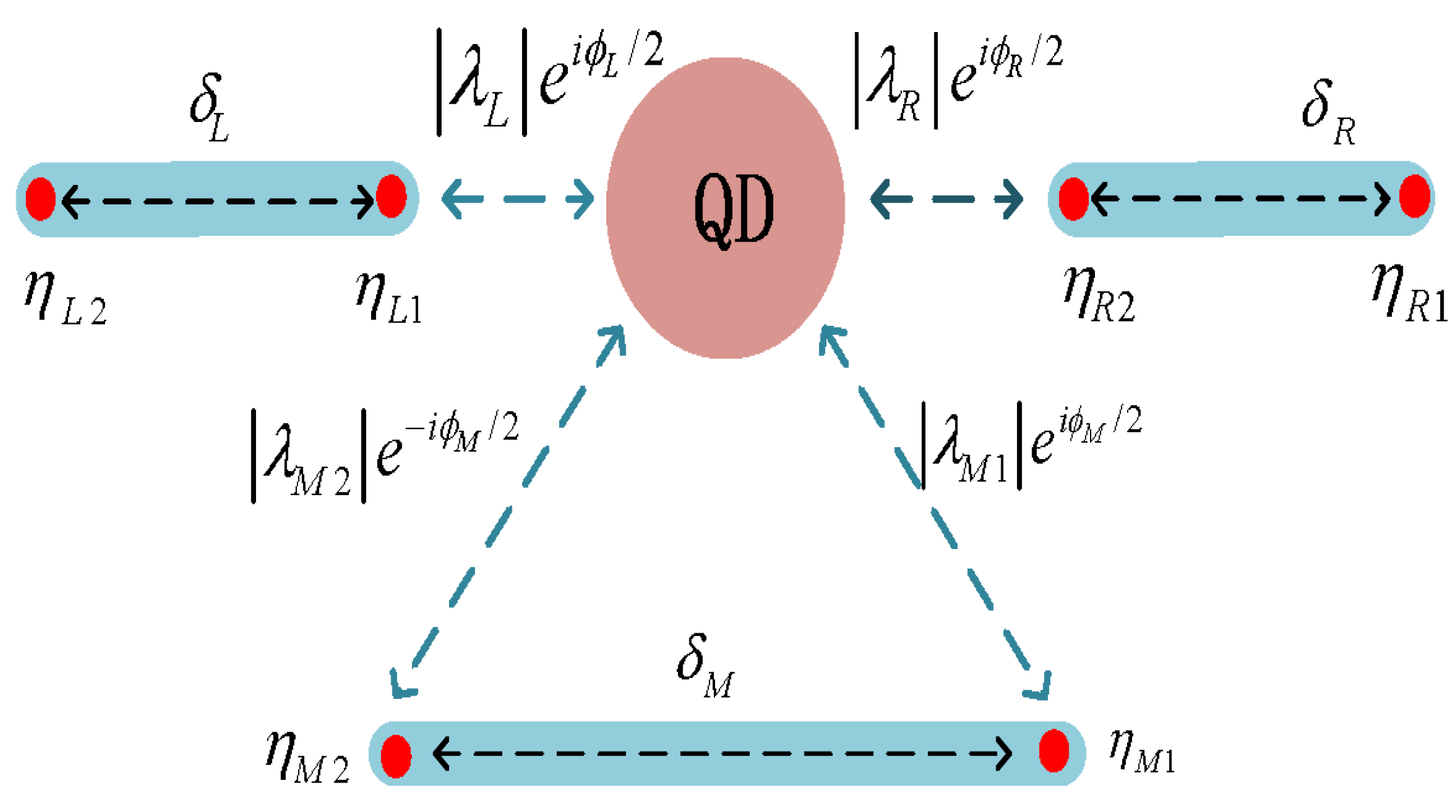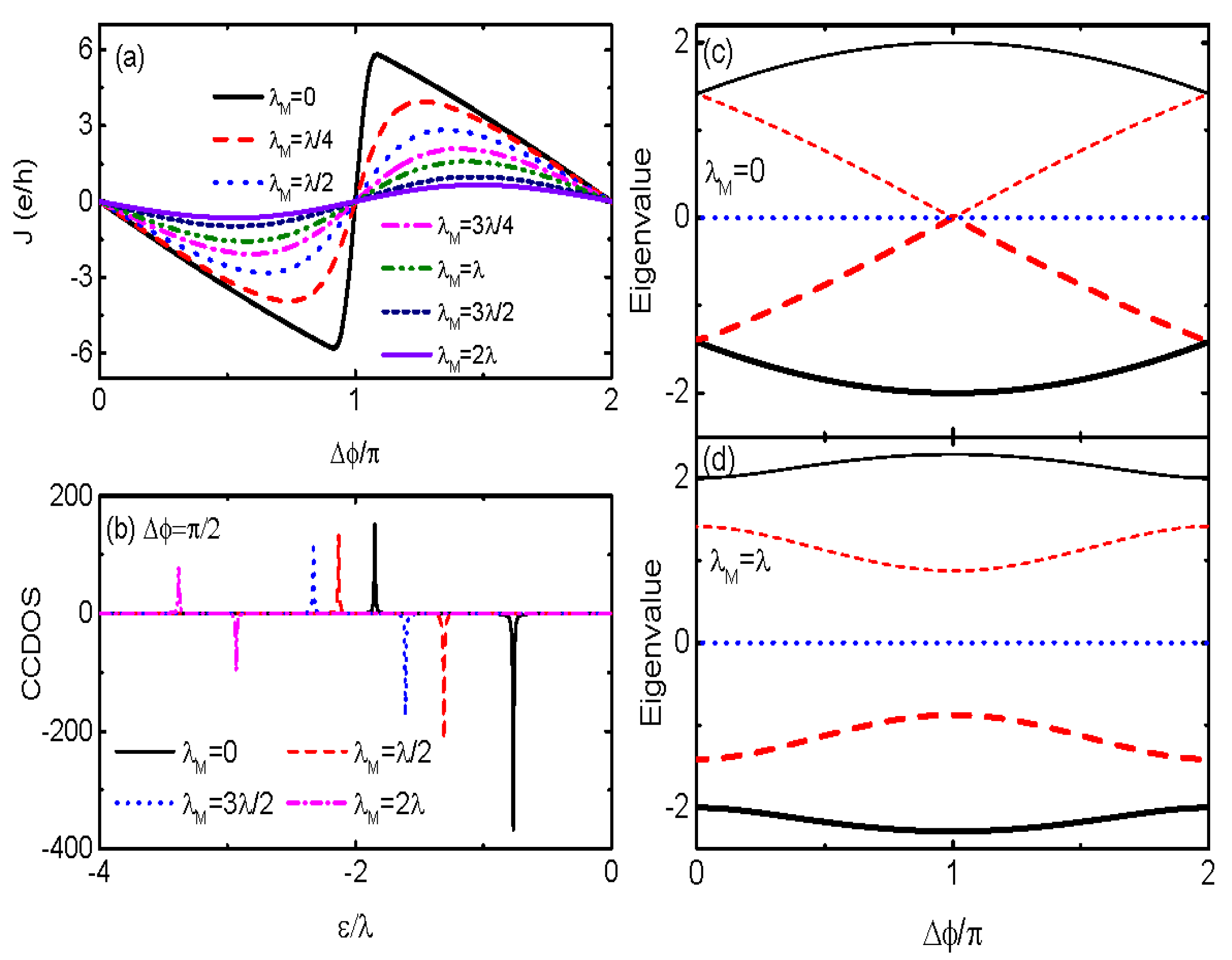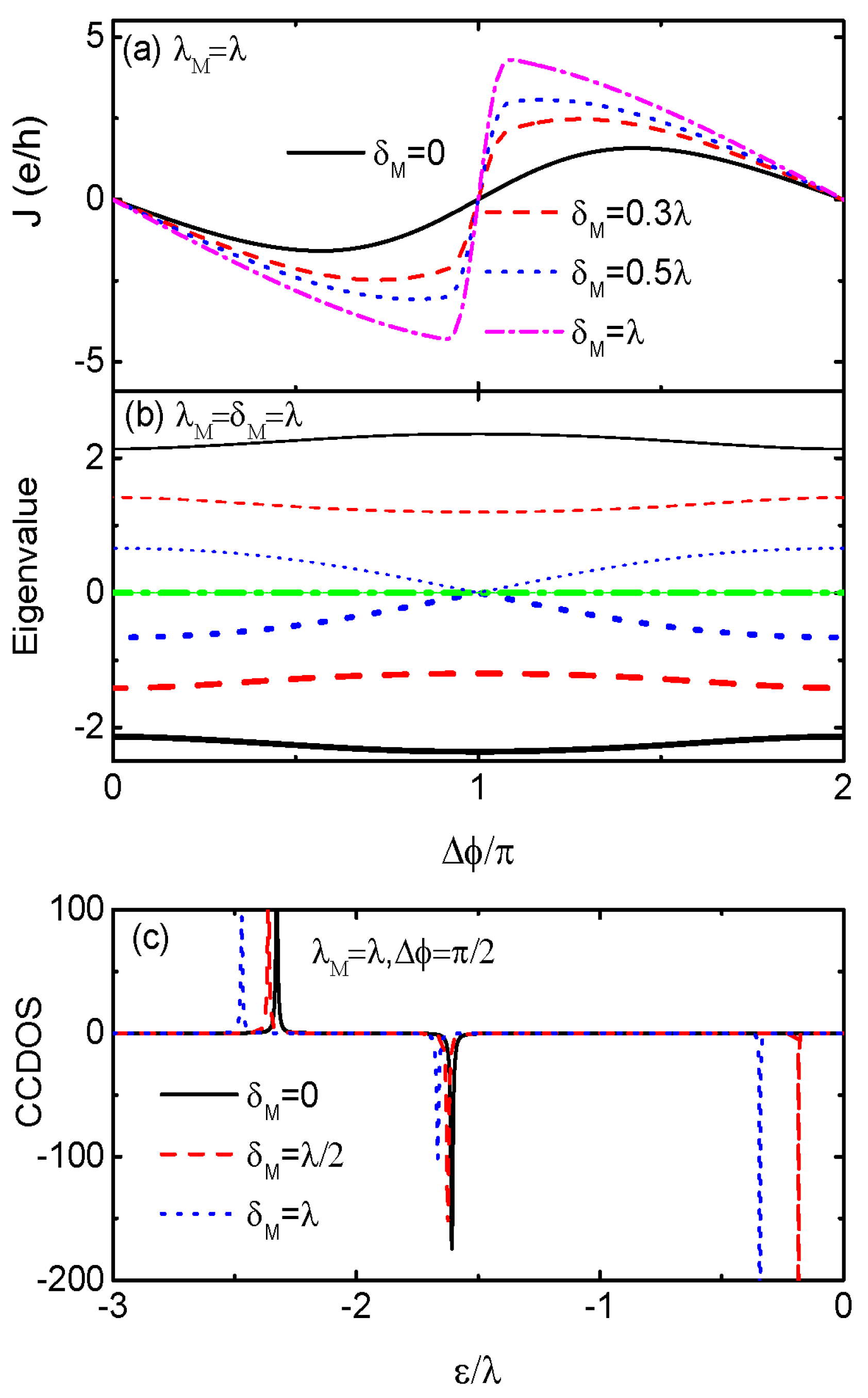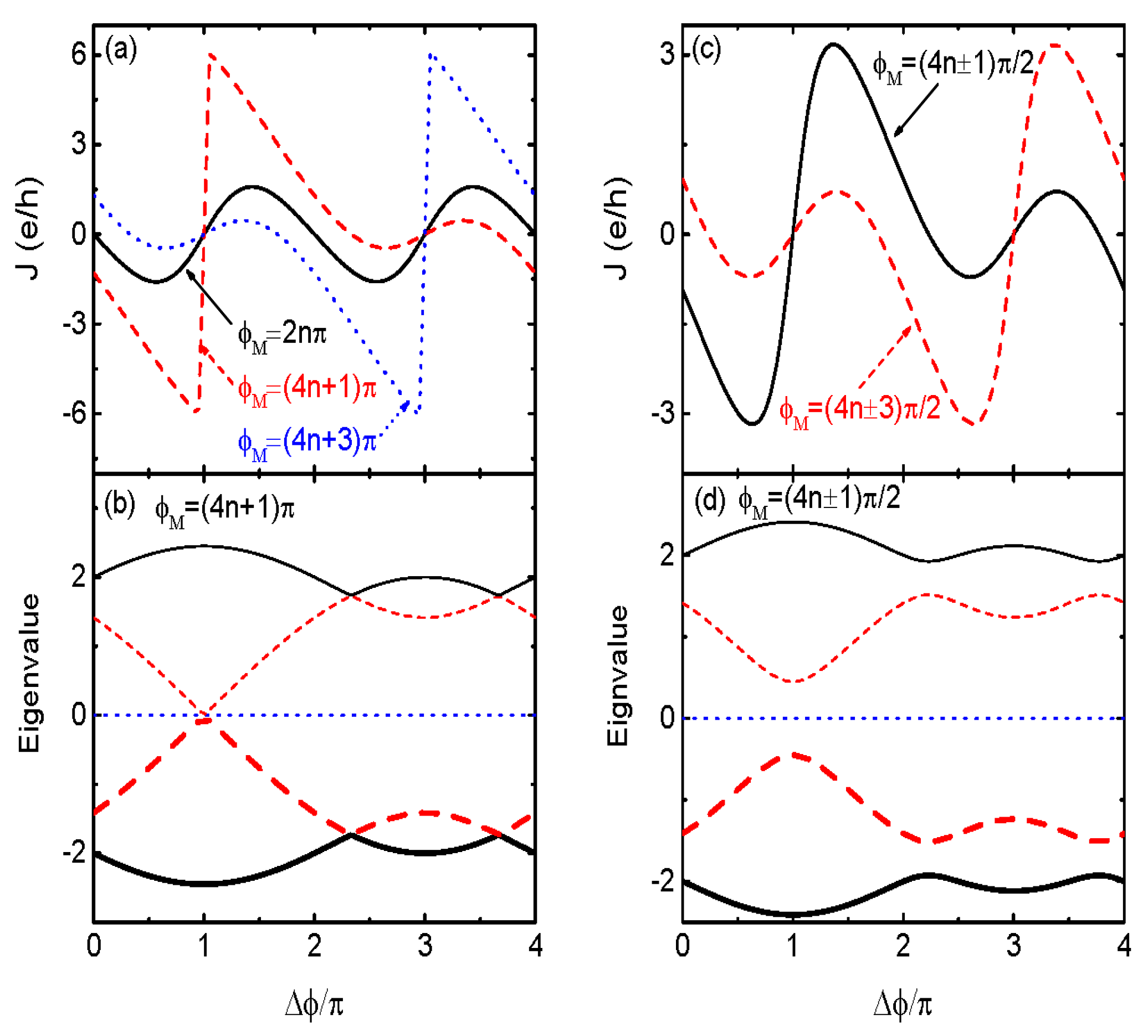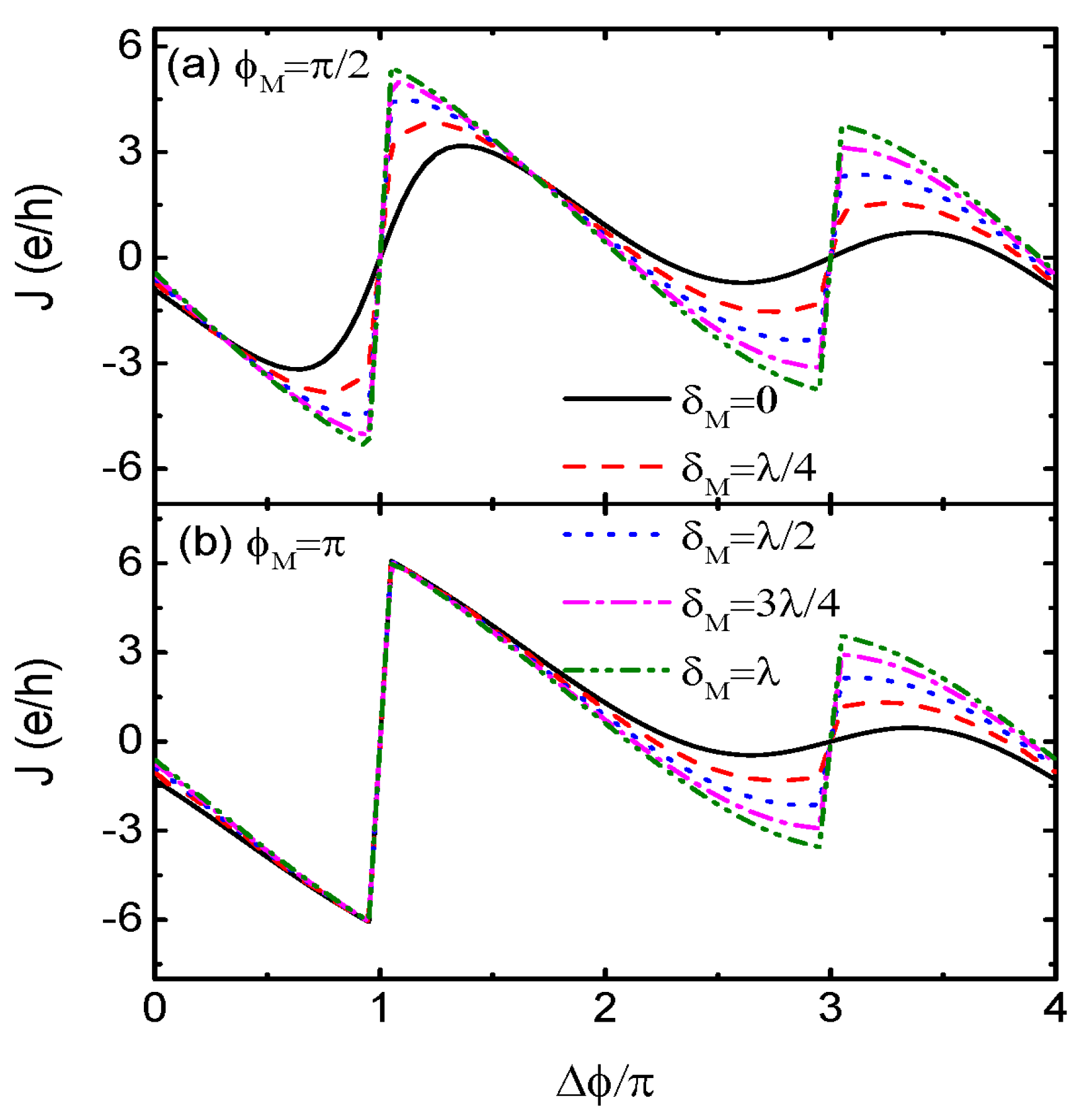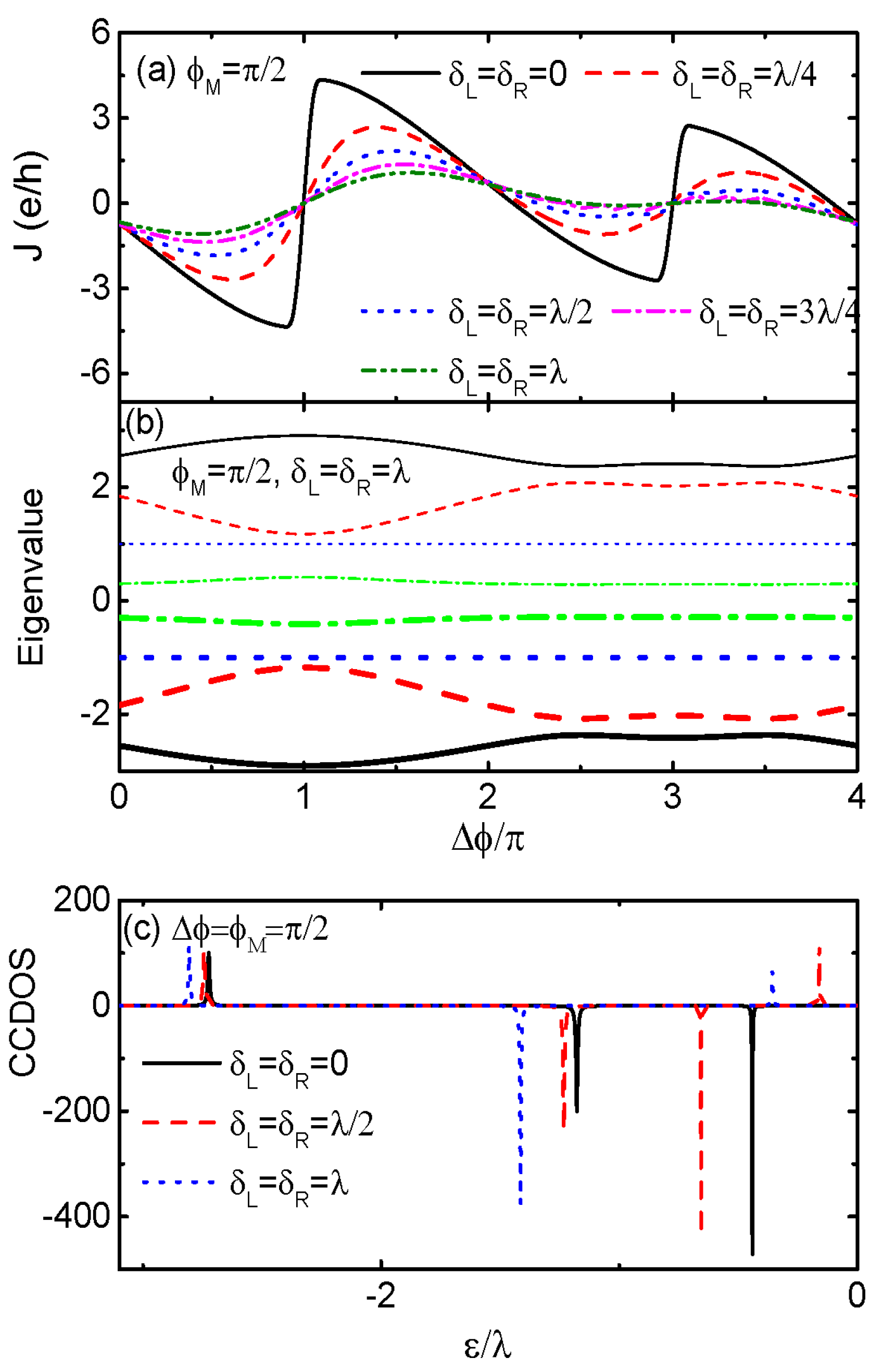1. Introduction
Investigations on the physics of Josephson tunneling dates back to 1962 [
1], when a supercurrent that flows through a Josephson junction composing two superconductors separated by a thin insulator film was theoretically predicted. According to the Bardeen–Cooper–Schrieffer (BCS) theory, superconductivity arises from the strong positive correlation between two electron states whose momentum and spin are equal in magnitude but opposite in directions, the so-called Cooper pairs. Josephson [
1] found that under some certain conditions the Cooper pairs tunnel from the left superconductor to the right one through the thin insulator, leading to the Josephson current without bias voltage being applied across the two superconductors. This dc Josephson current arises from the difference in the phase of the two superconductors. In the presence of bias voltage, the Josephson current oscillates quickly, and the net current is zero. The exotic Josephson effect was verified in subsequent experiments and strongly supported the BCS theory. In the earlier years of this discovery, it was applied to the design of superconducting quantum interference devices for detecting tiny variations in the magnetic fields [
2]. Electronic circuits made of two Josephson junctions are very useful in constructing quantum computers, medical diagnostic devices, and extremely sensitive magnetometers and voltmeters [
2].
With the rapid development of nanofabrication techniques, the original insulator film sandwiched between the two superconductors was replaced by various other thinner and thinner materials, resulting in more pronounced quantum effects. Such quantum Josephson junctions behave like artificial atoms [
3,
4] and have become cornerstones in superconducting electronics providing state-of-the-art performance in various applications, such as quantum computing [
5], photon dectors [
6], tunnel diode [
7,
8], and superconducting thermoelectric devices [
9,
10], etc. In particular, when quantum dots (QDs) with controllable and discrete energy levels are inserted between two superconductors to replace the traditional insulator material, the Josephson tunneling processes become even more interesting [
11,
12]. For example, Andreev bound states (ABSs) are formed by superposition of the Cooper pair and QD states and become the main contribution to the Josephson current. Therefore, the Josephson effect in the superconductor–QD–superconductor structures can be controlled by changing the dot size, shape, or materials in addition to those conventional means [
13,
14,
15,
16,
17,
18].
Recently, much work concerning the Josephson effect has shifted towards junctions composed of topological superconductors realized by conventional nontopological ingredients, such as Shiba chains realized by magnetic Fe atoms deposited on the surface of Pb, which is an s-wave superconductor having strong spin-orbit interaction of Rashba type [
19,
20], or a conventional s-wave superconductor sandwiched between two-dimensional electron gases (2DEGs) with strong Rashba spin-orbit interaction [
21]. There are also some works concerning hybridized junction with topological properties realized by particular design with conventional materials, for example, an InAs 2DEG proximitized by an epitaxial Al layer [
22] and HgTe quantum well coupled to Al thin-film [
23]. These new Josephson junctions provided important experimental platforms for the preparation, detection, and manipulation of the Majorana bound states (MBSs) [
19,
20,
21,
22,
23,
24,
25,
26,
27]. The MBSs are exotic quasiparticles of Majorana fermions recently prepared at the edges of topological superconductors typically realized in HgTe/CdTe quantum wells [
26]. These spatially separated zero-energy states obey non-Abelian statistics and are charge-neutral. Such unique natures enable them to be promising in applications of fault-tolerant topological quantum computation [
27], spintronics [
28], or thermoelectricity [
29,
30,
31,
32], etc. For example, the MBSs generally couple to electrons only of a certain spin direction due to their helical property and leave electrons of the other spin direction unaffected [
26,
28]. Consequently, a spin-polarized current or electron state naturally occurs in the presence of MBSs. Moreover, the spin-selective coupling between the MBSs and electrons are tunable in experiments [
33,
34,
35], leading to more interesting phenomena. In systems composed of a QD and nanowires hosting MBSs, the thermopower and thermoelectric efficiency might be obviously enhanced, in addition to the sign reversion of thermopower by interaction between the dot and the Majorana fermions [
29,
30,
31,
32]. Currently, the detection of the MBSs is still challenging [
36,
37].
Motivated by the studies on the Josephson junction with topological superconductors, some recent work has been devoted to the devices consisting of a QD inserted between two semiconductor Majorana nanowires approximated with an s-wave superconductor [
38,
39,
40]. The Josephson current driven by the topological phase associated with the MBSs in these structures is robust against the variation in the dot level, which is quite different from the case of usual resonant tunneling driven by the normal phase [
38,
39,
40]. When the MBSs are coupled to electrons of both the two spin directions on the QD, the Josephson current can be adjusted by the dot level, magnetic fields, and the overlap between the MBSs in each nanowire [
38,
39,
40].
Although the magnitude of the Josephson current in the abovementioned two-terminal Josephson junctions can be efficiently adjusted, the current’s period is difficult to alter. In view of this issue and those previously published works concerning multiple-terminal Josephson junctions [
14,
41,
42,
43], here, we propose a QD/Majorana-trijunction hybridized device to control both the magnitude and the period of the Josephson current. We emphasize that the proposed device is within the reach of present-day nanofabrication technologies, and the unique functions brought about by the additional third junction are difficult to realize in those two-terminal setups. As is plotted in
Figure 1, a single-level QD couples simultaneously to three semiconductor nanowires (junctions) hosting MBSs at their ends [
33]. We focus on the Josephson current flowing between the left and right junctions, and the third nanowire functions as the current’s regulator. Our calculation results show that when the phase factor of the regulator junction
is zero, the Josephson current can be either strengthened or weakened by system’s parameters about the MBSs and a
-period function of the phase difference between the two junctions. At finite phase factor
, the current’s period becomes
with respective to both phase difference
and
. Consequently, the flow direction of the Josephson current can be changed in addition to its tunable magnitude, which is useful in superconductor-based quantum devices.
2. Model and Method
We study the device presented in
Figure 1, in which a spinless QD is hybridized to triple semi-conductor nanowires hosting MBSs. The system’s total Hamiltonian can be divided into two parts [
38,
39]:
, in which
is for the QD with creation (annihilation) operator
and energy level
. Here the intradot Coulomb repulsion between electrons is neglected as the zero-energy MBSs mainly affects the transport processes around the Fermi level of the junctions
, which are set to be zero [
25,
34,
35,
40]. The Hamiltonian
describes the MBSs prepared at the ends of the Majorana trijunction, as well as the interaction with the QD [
38,
39,
44],
where
is the coupling strength between the MBSs existing at the different ends of the
-th nanowire. Note that in the the present paper, we are interested in the Josephson current flowing between the two Majorana junctions, and the middle one is used as a regulator. We then assume that the QD is individually coupled to
and
due to the pairwise of the MBSs [
38,
39,
44]. Accordingly, we have
and
, with
. The quantity
in the above expressions
is the interaction strength between the QD and the left and right Majorana junction, and
is the phase factor arising from the substrate superconductors in contact with the Majorana junctions. It is known that the difference between the phase factors gives rise to the Josephson current. As for the middle Majorana junction, we assume that both of the MBSs on it interact with the electrons on the QD, and [
33,
34,
42,
44]
in which
. In the Hamiltonian
, the operators for
obey the commutation relation of
and
. As usual [
38,
39,
44], we perform a unitary transformation to convert the MBSs representation into a regular fermion one by
and
. The Hamiltonian
then becomes
in which
,
, and
. The eigen-energy of the system is obtained by diagonalizing the whole Hamiltonian in matrix form. Under the generalized Nambu representation with the field annihilation and creation operators [
38,
45],
and
, the whole system’s Hamiltonian is given by following block matrix:
where the sub-matrices are
and
, where
is the usual Pauli matrix of the
z-component. The sub-matrices describing hopping between the QD and the Majorana junctions satisfy
, and their explicit expressions are,
and
We calculate the dc Josephson current between the left and right Majorana junctions in terms of the nonequilibrium Green’s function technique, and its explicit expression is as follows [
38,
46,
47],
where the quantity
stands for the difference between the self-energies due to the left and right Majorana junctions, with
. The retarded/advanced Green’s function for the
-th Majorana junction without interaction with the QDs is
. The total retarded/advanced Green’s function for the QD in Equation (
8) is [
38]
in which
is a unitary matrix. Note that a Dynes Broadening
is added in the QD Green’s function, whose value is set to be
[
43]. The equilibrium Dirac–Fermi distribution function in the expression of the Josephson current is
, with
the Boltzmann constant and
T the temperature in equilibrium state. In the present paper, we only consider the case of zero temperature (
).
3. Numerical Results
In the following numerical calculations, we focus on the situation of identical left/right Majorana junctions by choosing
as the energy unit with
[
38]. As was found in previous works [
38,
39,
40,
42,
43], the Josephson current generally reaches its maximum value when the Fermi levels of the junctions are aligned to the dot level, which is adjustable by gate voltages, its chemical compositions, and sizes. When the dot level is tuned to deeper or higher energy regimes, the magnitude of the current is suppressed. Accordingly, here, we fix the dot level
and focus on the impacts of the regular junction.
Figure 2a presents the Josephson current varying with respective to the phase difference
and different
. When the QD is free from coupling to the middle Majorana junction (
), the Josephson current is characterized by the abrupt sign change (jump) at
as shown by the black solid line. The period of the current with respective to the phase difference is
, which is in agreement with previously published work [
34,
35,
36]. When the QD is coupled to the middle Majorana junction
,
Figure 2a shows that the strength of the current is reduced obviously with increasing
, whereas the jump at
and the period of the current remain unchanged regardless of the value of
. The
curve becomes a sinuous lineshape, which has also been found in previous works [
38,
39,
40,
42,
43].
Influences of the middle Majorana junction on the Josephson current can be understood by examining the CCDOS and the energy diagram. In the absence of the middle Majorana junction (
), there are two peaks with opposite signs in the CCDOS (black solid line) for
[
46]. The negative peak is higher than the positive one, and then the current is negative. Note that here we only show the CCDOS in the negative energy regime that contribute to the Josephson current at zero temperature. There are also a pair of peaks in the CCDOS in the positive energy regime, which are not shown in the figure as they have no contribution to the current. With increasing
, the peaks in the CCDOS are shifted toward deeper energy regimes with an obvious reduction in the height. The magnitude of the current then is suppressed accordingly.
Figure 2c,d shows the eigenvalue (ABSs) of the system Hamiltonian in Equation (
4) for zero and finite
, respectively. It is known that the Josephson current is contributed to from two parts [
38,
39,
46,
47], of which one is the continuous part
arising from an electron whose energy
is outside of the superconducting gap. The other part is the discrete one
due to electrons tunneling through the ABSs formed within the superconducting gap. Usually, the contribution from the discrete part is larger than the continuous one and is related to the ABSs by
[
39,
46,
47]. For
, there are two pairs of non-zero ABSs in
Figure 2c. The states’s energy denoted by the black solid lines changes slowly with respect to the phase difference and then has a smaller contribution to the Josephson current. The slopes of the red dashed curves, however, are quite large, and the ABSs denoted by them have a larger contribution to the current. Moreover, at the point of
, the black solid and red dashed curves have individual maximums and zero-energy crossing points; then, the Josephson current is zero. For
, as shown in
Figure 2d, the ABSs denoted by the red dashed lines depart from the zero point (Fermi level of the Majorana junctions). Meanwhile, it is shown that the ABSs changes even more slowly as compared to
Figure 2c. Due to the above two reasons, the strength of the Josephson current is weakened as shown in
Figure 2a.
Next, we study the impacts of the inter-MBS hybridization within the middle Majorana junction
on the Josephson current. The strength of
arises from the overlap of the Majorana wavefunctions and depends the length of the nanowire [
26,
27,
33,
34],
, where
denotes the length of the nanowire and
the superconducting coherence length. Here, we set
, since they will suppress the Josephson current as described in Refs. [
38,
39].
Figure 3a indicates that the magnitude of the Josephson current is enhanced monotonously by increasing
, while the jump at
remains unchanged. We emphasize that the function of
in the side-coupled Majorana junction is totally different from that of
. A similar result was also found in a previous work [
42]. The reason is that the overlap between the MBSs in the middle (side-coupled) junction induces new ABSs or, in other words, lifts the degeneracy of the ABSs [
38]. This can be seen from the energy diagram and CCDOS.
Figure 3b shows that another pair of non-zero ABSs (the blue dot lines) are induced by a finite
, the slopes of which are quite large as compared to the states denoted by the black and red curves. This is confirmed by the CCDOS in
Figure 3c, in which a new peak around the Fermi level emerges in the case of
. When the electron energy moves away from the Fermi level, the peaks in the CCDOS are shifted to even deeper energy regimes with slightly reduced height, and the contributions to the current are weakened. This can also be confirmed by the slower change in the red dashed and black solid curves in
Figure 3c varying as a function of the phase difference for finite
.
We studied, as shown in
Figure 4, the influences of
on the Josephson current under the condition when the QD is symmetrically coupled to the trijunction, i.e.,
. We find that the current’s period becomes
in the presence of
as shown in
Figure 4a,c. The zero points of the current remain at
, where
regardless of the value of
. The analytical expression of the current in the present symmetrical structure can be written as follows (zero dot level
):
in which
is the self-energy induced by the MBSs, and
is the denominator of the retarded Green’s function,
Equation (
10) indicates that the current in this Majorana trijunction can be divided into two parts, of which one is the usual Josephson current proportional to
. The other part arises from the quantum interference effect in the presence of the middle junction and is proportional to
. It determines the main characters of the current; for example, the current is a
period function of both
and
.
Figure 4b gives the energy diagram for
, from which one can see that the ABSs reach maximums at
, where the current changes sign.
Figure 4d presents the energy diagram for
and shows that the ABSs changes much more slowly than that in
Figure 4b, and then the current is suppressed. We emphasize that by adjusting the phase factor of the middle Majorana junction, both the strength and the sign of the current can be tuned, which may be useful in designing Josephson-based instruments.
Figure 5 and
Figure 6 show the impacts of the Majorana interactions in the nanowires on the Josephson current for a finite
. Similar to the case in
Figure 3, the direct overlap between the MBSs in the middle junction
enhances the current’s amplitude as shown in
Figure 5a,b. The abrupt change in the current at
remains unchanged in the presence of
. The enhancement of the current by
depends on the value of both
and
. For
in
Figure 5a, the current is obviously enhanced in the whole
regime except for several particular values. Whereas for
as shown in
Figure 5b, the Josephson current almost remains unchanged regardless of the value of
in the regime of
. As for
, the behavior of the current is similar to that in
Figure 5a. These results enrich the manipulation means of the Josephson current.
Figure 6a indicates that the current is significantly suppressed by Majorana interactions
in the left/right nanowire, which act as the electrons’ source/drain. This result is in agreement with the previously published work because the overlap between the MBSs in the left and right Majorana nanowires destroy their zero-state [
34]. As mentioned above, the MBS–MBS interaction in the middle junction plays a totally different role compared to those in the left and right junctions, since the states it induces carry the current in the same direction as the case of
.
Figure 6b shows that the degeneracy of the ABSs is totally broken in the presence of
and
, i.e., all four pairs of the ABSs depart from zero energy. The slopes of the ABSs are also changed as compared to
Figure 3, which results in a reduction in the current.
Figure 6c shows that the CCDOS has a triple-peak configuration in the presence of
, which is different from that in
Figure 3c. There are two higher negative peaks in the shallower energy regime and a lower positive one in the deeper energy regime for
, resulting in a negative current. Turning on the MBS–MBS interaction in the left and right junctions (
), a new positive peak emerges in the CCDOS as is shown by the dashed red and blue dotted curves in
Figure 6c. They arise from the new non-zero state as denoted by the green dashed–dotted lines in
Figure 6b. For
, the two negative peaks in shallower energy regimes survive (the red dashed line), but one of them disappears and moves to a deeper energy regime for
(red dotted line). The positive peak in the deep energy regime is less influenced by
. Due to the behaviors of the energy diagram and the CCDOS, the current’s amplitude is reduced by the Majorana interaction in the left and right junctions.
